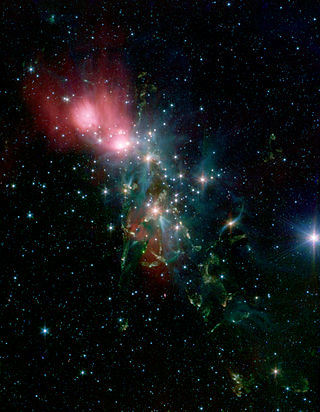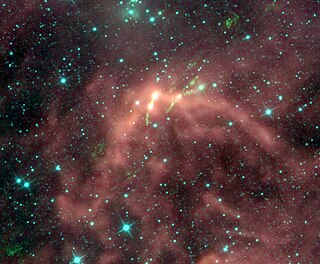
In stellar evolution, an FU Orionis star is a pre–main-sequence star which displays an extreme change in magnitude and spectral type. One example is the star V1057 Cyg, which became 6 magnitudes brighter and went from spectral type dKe to F-type supergiant during 1969-1970. These stars are named after their type-star, FU Orionis.

Meissa, designated Lambda Orionis is a star in the constellation of Orion. It is a multiple star approximately 1,300 ly away with a combined apparent magnitude of 3.33. The main components are an O8 giant star and a B-class main sequence star, separated by about 4″. Despite Meissa being more luminous and only slightly further away than Rigel, it appears 3 magnitudes dimmer at visual wavelengths, with much of its radiation emitted in the ultraviolet due to its high temperature.

The Orion molecular cloud complex is a star-forming region with stellar ages ranging up to 12 Myr. Two giant molecular clouds are a part of it, Orion A and Orion B. The stars currently forming within the complex are located within these clouds. A number of other somewhat older stars no longer associated with the molecular gas are also part of the complex, most notably the Orion's Belt, as well as the dispersed population north of it. Near the head of Orion there is also a population of young stars that is centered on Meissa. The complex is between 1 000 and 1 400 light-years away, and hundreds of light-years across.

NGC 1333 is a reflection nebula located in the northern constellation Perseus, positioned next to the southern constellation border with Taurus and Aries. It was first discovered by German astronomer Eduard Schönfeld in 1855. The nebula is visible as a hazy patch in a small telescope, while a larger aperture will show a pair of dark nebulae designated Barnard 1 and Barnard 2. It is associated with a dark cloud L1450. Estimates of the distance to this nebula range from 980–1,140 ly (300–350 pc).

Z Canis Majoris (Z CMa) is a B-type star in the constellation of Canis Major. It has an average apparent visual magnitude of approximately 9.85, though has brightened by 1-2 magnitudes in irregular outbursts in 1987, 2000, 2004 and 2008.

FU Orionis is a variable and binary star system in the constellation of Orion, that in 1937 rose in apparent visual magnitude from 16.5 to 9.6, and has since been around magnitude 9. The name FU Orionis is a variable star designation in the Argelander system, which are assigned sequentially as new variables are discovered. FU Orionis is about 1,360 light years distant and is associated with the molecular cloud Barnard 35.

AA Tauri is a young variable star in the equatorial constellation of Taurus, located in the Taurus-Auriga star-forming region. It is too faint to view with the naked eye, having an apparent visual magnitude that varies from 12.2 down to 16.1. The star is located approximately 447 light years away from the Sun based on parallax, and is drifting further away with a radial velocity of +17 km/s.

The Lambda Orionis Cluster is an open star cluster located north-west of the star Betelgeuse in the constellation of Orion. It is about five million years old and roughly 1,300 ly (400 pc) away from the Sun. Included within the cluster is a double star named Meissa. With the rest of Orion, it is visible from the middle of August in the morning sky, to late April before Orion becomes too close to the Sun to be seen well. It can be seen from both the northern hemisphere and the southern hemisphere.

25 Orionis, less commonly known by its Bayer designation Psi1 Orionis is a fifth-magnitude star in the constellation Orion. It lies among a dense cluster of low-mass pre-main-sequence stars in the Orion OB1a.

Pi1 Orionis (π1 Ori, π1 Orionis) is a star in the equatorial constellation of Orion. It is faintly visible to the naked eye with an apparent visual magnitude of 4.74. Based upon an annual parallax shift of 28.04 mas, it is located about 116 light-years from the Sun.

Pi6 Orionis (π6 Ori, π6 Orionis) is a solitary star in the eastern part of the constellation Orion. It is visible to the naked eye with an apparent visual magnitude of 4.469. Based upon an annual parallax shift of 3.45 mas, it is around 950 light-years from the Sun. At that distance, the visual magnitude of the star is reduced by an interstellar absorption factor of 0.52.

31 Orionis is a binary star system in the equatorial constellation of Orion, located near the bright star Mintaka. It is visible to the naked eye as a faint, orange-hued point of light with a baseline apparent visual magnitude of 4.71. The distance to this system is approximately 490 light years away based on parallax, and it is drifting further away with a mean radial velocity of +6 km/s.

69 Orionis is a single star in the equatorial constellation of Orion, positioned a couple of degrees to the north of Xi Orionis. It has the Bayer designation f1 Orionis; 69 Orionis is the Flamsteed designation. The star is visible to the naked eye as faint, blue-white hued point of light with an apparent visual magnitude of 4.92. It is located approximately 530 light-years from the Sun based on parallax, and is drifting further away with a radial velocity of +22 km/s. In 2015, H. Bouy and J. Alves suggested that it is a member of the newly discovered Taurion OB association.
23 Orionis is a double star located around 1,200 light-years away from the Sun in the equatorial constellation of Orion. It is visible to the naked eye as a dim, blue-white-hued point of light with a combined apparent visual magnitude of 4.99. The pair are moving away from the Earth with a heliocentric radial velocity of +18 km/s, and they are members of the Orion OB1 association, subgroup 1a.

Phi1 Orionis is a binary star system in the constellation Orion, positioned less than a degree to the south of Meissa. It is visible to the naked eye with an apparent visual magnitude of 4.42. The distance to this system, based upon an annual parallax shift of 3.0 mas, is around 1,090 light-years.

Phi2 Orionis is a star in the constellation Orion, where it forms a small triangle on the celestial sphere with the nearby Meissa and Phi1 Orionis. This star is visible to the naked eye with an apparent visual magnitude of 4.081. Based upon an annual parallax shift of 27.76 mas, it is located around 117 light-years from the Sun.

GW Orionis is a T Tauri type pre-main sequence hierarchical triple star system. It is associated with the Lambda Orionis star-forming region and has an extended circumtrinary protoplanetary disk.

The dark nebula Barnard 203 or Lynds 1448 is located about one degree southwest of NGC 1333 in the Perseus molecular cloud, at a distance of about 800 light-years. Three infrared sources were observed in this region by IRAS, called IRS 1, IRS 2 and IRS 3.

HD 150193 is a binary star system in the constellation of Ophiuchus. The primary star was identified as a Herbig Ae/Be star with a strong solar wind, losing approximately a tenth of solar mass per million years. It does host a very small debris disk, likely due to disk truncation by the nearby stellar companion. The disk is inclined 38±9° to the plane of sky. It appears to be highly evolved and asymmetric, with indications of flattening and grains growth.

UX Orionis is a variable star in the constellation of Orion. It is a Herbig Ae star, located about 1000 light years from the Earth. At its brightest it is a magnitude 9.5 object, so it is too faint to be seen with the naked eye. UX Orionis is the prototype of the UX Orionis class of variable stars, which are young stellar objects that exhibit large, irregular changes in visual band brightness. UX Orionis was discovered by Henrietta Swan Leavitt.













